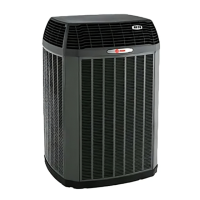
Do you have a question about the Trane 4TWX8 and is the answer not in the manual?
| Model Number | 4TWX8 |
|---|---|
| Category | Heat Pump |
| HSPF Rating | Up to 10 |
| Refrigerant | R-410A |
| Warranty | 10 year limited warranty on compressor |
Details the physical dimensions and estimated weights for different condensing unit models.
Specifies maximum total length and vertical change allowed for refrigerant lines.
Provides guidance on unit placement for optimal airflow, noise reduction, and avoiding weather impacts.
Recommends precautions for units installed in areas with snow and freezing temperatures.
Advises on protective measures for units installed near salt water environments.
Outlines steps to check for damage and safely remove the unit from its pallet.
Details requirements for installing the unit on a support pad, including size, levelness, and code compliance.
Presents a table specifying line sizes and service valve connection sizes for different models.
Explains the factory charge for the condensing unit and connecting lines, emphasizing verification.
Instructs on determining the required total line length and vertical change for system configuration.
Emphasizes the importance of insulating the vapor line and preventing contact between lines.
Provides precautions for using existing refrigerant lines, focusing on brazing and line condition.
Details best practices for routing refrigerant lines to prevent noise and ensure proper installation.
Provides a step-by-step guide for the proper brazing process of refrigerant lines.
Details the procedure for pressurizing lines with nitrogen and checking for leaks using soapy solution.
Explains the process of evacuating the system to a specific micron level using a vacuum pump and micron gauge.
Guides on how to properly open the gas service valve after leak check and evacuation.
Provides instructions and warnings for opening the liquid service valve, emphasizing caution.
Presents a table defining maximum lengths for low voltage wiring based on wire gauge.
Illustrates wiring connections for thermostats, air handlers, and outdoor units for different control systems.
Explains the defrost control settings, termination temperatures, and checkout procedures.
Emphasizes ensuring high voltage power supply matches equipment nameplate and complies with codes.
Recommends installing a separate disconnect switch and using flexible conduit for high voltage connections.
States the requirement to ground the outdoor unit according to national, state, and local codes.
Details the step-by-step procedure for safely starting up the installed system, including waiting periods.
Explains the necessity of measuring outdoor and indoor temperatures for accurate system charging.
Provides charts and steps for adjusting system charge using subcooling for outdoor temps above 55°F.
Recommends weighing the charge in heating mode for outdoor temps below 55°F, referencing pressure curves.
Lists essential checks and procedures to ensure proper system operation and performance post-installation.
Offers a fault guide correlating system faults with potential causes for refrigerant and electrical issues.
